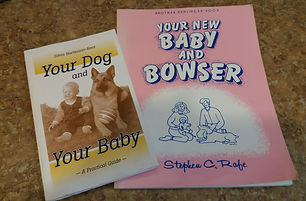
Making tails wag since 1996!
3400 N. Monroe St. - Spokane, WA
Questions? EMAIL!
Diamonds in the Ruff
Kids in the Classroom
Diamonds in the Ruff encourages whole family participation; however there are special safety concerns and responsibilities for parents who choose to include their children in their dog's learning experience:
Quiet voices and bodies are required in class.
The dogs will be excited, distracted and apprehensive in class. Your dog may not act like the calm dog who lives in your house. High noise levels are stressful, and fast moving, excitable children add even more to the stress level of the dogs. Think "calm".
The trainer is the only one who should be instructing the dog.
The dog will become confused if he's trying to listen to everyone at once. If the child is working the dog, the parent should not be giving cues.
Children should wait their turn quietly and not be bouncing around their dog (or ANY student's dog) while it is trying to concentrate. Dogs cannot listen and follow directions when distracted. They need space and focus to learn new things. The classroom is exciting enough!

Start 'em young! Mom and dad are right there, guiding this very young trainer and her puppy. This is the beginning of a great relationship!

A parent should hold the leash while a child trains the dog.
For safety, the one holding the leash should outweigh the dog! This includes when taking the dog out for bathroom breaks and when entering or leaving the classroom. Keep the leash slack! As long as the dog is focused on the child, the leash should not inhibit the dog's movement or ability to follow cues or stay close to their trainer. DO use the leash as a brake pedal to stop the dog from leaving your training area or become a distraction for another dog or person.
How old should my child be to take part in the training?
It really depends on the child. If they can remain focused on the lessons for the hour-and-a-half and remain quiet so as not to distract the other dogs or disrupt the other students' class experience, even younger children can take part in training.
The younger the child, the more guidance and coaching the parent will be required to do, at home and in class. It is generally best if the parent introduces new exercises. They should practice until the dog has a good mastery of the skill before showing the child how to do the exercise with the dog. This will make it easier and less frustrating for both the dog and the child. Your goal is to set both the child and the dog up for success.
Older children may take over the role of primary handler of their dog. Mom and/or Dad will still need to take on the active role of coach and provide guidance and encouragement along the way. Keep it positive for both the child and the dog. No corrections, scolding, or nagging for either end of the leash!
THIS IS A DOG TRAINING CLASS - You will be directly responsible for helping your "well-trained child" to train your dog.

The definition of "well-trained child":
• Rule #1 - children must be able to do a long-duration (quiet) sit-stay.
• Rule #2 - children must follow directions on the first request
• Rule #3 - children must perform a reliable re-call from distraction (come when called)
Parent rules:
• Rule #1 - Two parents (adults) should accompany children under eight years of age (one to watch the child and one to train the dog - you may take turns, of course!)
• Rule #2 - No unattended children - supervise them at all times, please! Not all dogs are friendly and normally-friendly dogs may react totally out of character when stressed.
PARENTS - please remind your children of the importance of not approaching or feeding other students' dogs without permission from you AND the dog's owner. This includes the instructor's dogs. (The instructor's dogs may try to convince you that they are never fed and that it is ok to approach and feed them, but please know that they are lying.)
Thank you, for being responsible parents and dog owners and for giving your child the opportunity to learn to behave around dogs and have compassion for their well-being, and for caring enough to take the time to train your dog so it will be a safe and enjoyable companion for your child. Would you like to apply the training philosophy you've learned with your puppy to the raising of your children? Check out this excellent online parenting group!
It's hard to be "Mom" and "dog trainer" at the same time. This young mom has made sure to provide activities for her young ones so she can focus on her puppy and her puppy can focus on her! Everyone has what they need to succeed!
A second adult should be present to monitor the children, so the adult who is working with the dog can give their attention to the training lessons and instruction.
If the children need a break, Emerson Park is right around the corner, just west of the North Monroe training studio.
Is your dog struggling with its behavior around the kids? Visit this link for some tips.

Resources for Parents
Mom & Dad - if you are looking for great resources, check out these websites:
-
Living With Kids and Dogs by Colleen Pelar.
-
Family Paws Parent Education - Kids & Dogs, safe together
Preparing for New Baby - Toddlers
Essential books for parents and parents-to-be:



(c) Diamonds in the Ruff - All rights reserved